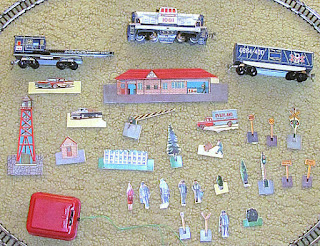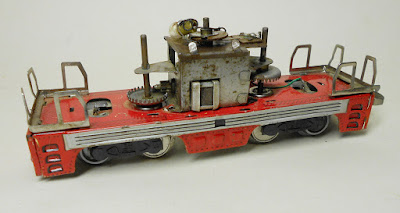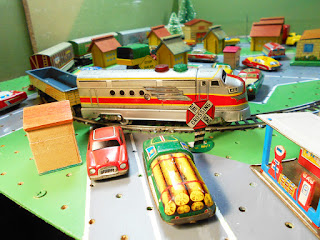 |
| Right color, but the wrong number of cars. |
Read all the installments of the Straco Express layout project here.
Recently I found -- and purchased -- three Nomura train sets in rapid succession. Individually, each one provided some additional information about Nomura's manufacturing processes and marketing. And collectively, they provided even more. This and the next two Straco Display Layout posts covers these three sets, with some cross-referencing between them.
Part 51 - Nomura Santa Fe Flashing Light Set
Part 52 - Nomura Milwaukee Road Flashing Light Diesel
Part 53 - Nomura/Rosko Flashing Light Train Set
The third Nomura set I found was a Rosko Electric Train Set. This set came in two different versions -- with and without a tank car. I was lucky enough to find a set with the tank car. Examining the set, along with photos of other sets and my recent acquisitions helped me flesh out my knowledge of this piece.
 |
This is the set found in the box pictured above. Note that
the train is blue (rather than red, as pictured on the box)
Also note the power pack and cardboard accessories. These
are identical to those in my Nomura-branded Santa Fe set. |
Even though it was branded as Rosko, this is clearly a Nomura-made set. The cars -- as well as the box top -- bear the "TN" Nomura brand. The box shape and design mirror those of the Nomura flashing light sets.
The cardboard figures that came with the set are the same that Nomura put in their own sets.
The locomotive is remarkable, both in construction and complexity. It's modeled on the GMD 1001, a General Motors demonstrator unit built in 1956, and retired in 1958. The GMD 1001 was designed to tow locomotives needing repair but didn't have the horsepower to handle the new, heavier diesel being built.
The unit had a two-year run GM London, Ontario locomotive plant.According to
Old Time Trains, only five other units were built. Those were shipped to Brazil.
 |
| The prototype for the Rosko/Nomura locomotive |
So how did such an obscure prototype come to the attention of Nomura's toy designers? Perhaps someone at Rosko in the States was a train buff. It's a mystery, for sure.
 |
| Not the two drive shafts on either side of the motor. |
Like the Nomura flashing light F3's the 1001 has a rotating light bulb. The mechanism is a little different, though. The light perches atop the motor. The cab has red opaque plastic windows for the light to (sort of) shine through, plus an opening on the top of the cab.
All of the other Nomura sets have two pieces of rolling stock. The Rosko set has three, and perhaps because of this, the 1001 has a beefed up motor. Unlike the F3's both trucks are powered through the same drive shaft.
 |
| This is the set I purchased. |
The rolling stock is also unusual. When I first obtained a Rosko box car, I noted the differences between it and the standard Nomura box car (see
Collecting and Collecting Information 15).

The other two Rosko cars are unique Nomura products. The tank car and the crane car share the same chassis. The crane car features an operating boom with a hand crank. The hook and line were missing, so I replaced them with jeweler's chain and a bent wire hook.
The loop and hook couplers have an interesting feature. The hooks are all bent to the left, so you can just slide the couplers together. Both the locomotive and the crane only have couplers at one end, so you're kind of limited in how you connect the cars together.
Overall, the set has a striking appearance. Not only are the pieces beautifully lithographed, but there's a lot of extra detail added. The box car has embossed slats; the crane car has an open cab for the boom cable.
 |
| The Rosko/Nomura set. Just as great-looking as the box art, I think. |
The GMD 1001 has multiple contoured surfaces, with a body that has five separate parts (plus a plastic horn) that needed to be joined by hand. By contrast, the Nomura F3 only has three pieces. It's a great addition to the Straco Display layout, and will probably be the last train set to join the collection. Unless I can find the two-car version in the blue livery, that is...
 |
| A great addition to the Sta |
Layout construction:
- Pegboard: $4.95
- Flathead Screws: $0.40
- Molding: $2.49
- SilClear: borrowed from a friend
- Green Paint: leftover from another project
- Wood Screws: $3.60
- Felt Pads: $1.99
Power Pack: $5.90
Small Houses: $3.00
Testor's Gray Paint for road: $1.29
Bandai Areo Station: $8.99
2 tinplate signs: $1.00
4 tinplate signs (with train) $5.99
Cragstan HO Light Tower $20.49
4 nesting houses $4.99
Tinplate gas station: $5.00
Vehicles:Two Japanese toy cars: $2.00
- A.W. Livestock truck: $4.99
- Taxi: $2.99
- Ambulance: $2.99
- Two Japanese patriotic cars: $6.99
- Haji three-wheel sedan $3.00
- Haji three-wheel tanker $5.00
- 1950's sedan $2.99
- LineMar Police Car $9.00
- LineMar Pepco Truck $8.50
- LineMar Bond Bread Van $8.00
- LineMar Fire Engine $4.95
- LineMar Dump Truck $12.99
- LineMar GE Courier Car $10.98
- LineMar County School Bus $9.99
- Nomura Red Sedan $5.00
- Nomura Police Car $2.52
- Nomura lumber truck $3.48
- 6 Nomura vehicles $16.99
- Orange Sedan $10.99
- King Sedan $9.95
- Indian Head logo sedan $4.99
- Indian Head (?) convertible $18.00
- Yellow/red Express truck $9.99
- Red limousine FREE
Total Project Cost: $238.35












































